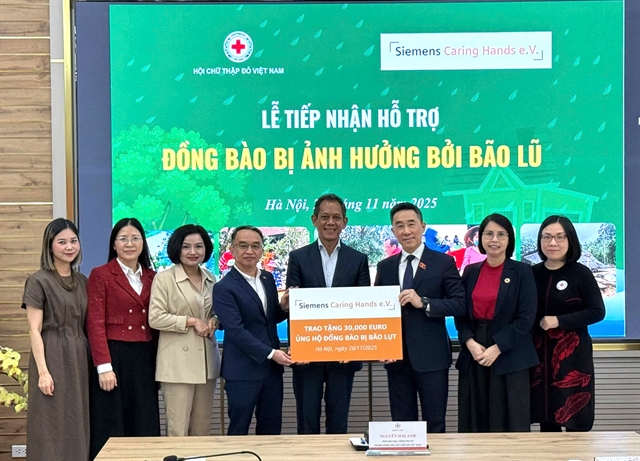 Economy
Economy
.png)

|
| Việt Nam's goods are exported mainly via the Hải Yến Km3+4 temporary pontoon bridge in Móng Cái City at present. VNA/VNS Photo |
HÀ NỘI — Quảng Ninh is strengthening mechanisms and policies and exploiting the strength of the expressway to ensure sustainable import-export development.
Vice chairman of Quảng Ninh Provincial People's Committee Bùi Văn Khắng said that Quảng Ninh Department of Industry and Trade together with border localities will establish e-commerce trading floors in border gate areas; and speed up the research to build a digital border gate platform for customs clearance of import and export goods.
At the same time, the department will guide businesses to implement stable and sustainable export activities, as well as follow regulations on the origin and standards of goods.
They will also improve the business environment, and have policies to encourage the private sector to develop logistics services and a warehouse system associated with port planning.
The vice chairman also suggested the business community should be proactive in building business and production plans, expanding export markets and proposing solutions on developing import-export and logistics activities.
The People's Committee of Quảng Ninh said that from the beginning of 2022, import and export activities through land border gates based in the province have faced many difficulties because China has been strengthening measures to prevent and control the COVID-19 pandemic.
Therefore, Việt Nam's goods are exported mainly via the Hải Yến Km3+4 temporary pontoon bridge in Móng Cái City, while goods imported from China to Viet Nam are mainly transported via Bắc Luân II international border gate in Móng Cái City and Hoành Mô border gate in Bình Liêu District.
Despite facing many difficulties, in the first nine months of 2022, the value of goods passing through provincial road border gates reached about US$2.4 billion, higher than that in Lào Cai and Lạng Sơn provinces. The goods exported through the border gates in Quảng Ninh had high export value such as aquatic, tapioca starch and industrial fiber products.
Total State budget revenue from border gates on land in the first nine months reached nearly VNĐ1.5 trillion, up 33 per cent on year.
Khắng said these were very impressive results for the import-export activities via the land border gates. This is evidence of the strong recovery in the enterprises' import-export activities.
However, this performance is still not commensurate with the potential for import-export activities. Quảng Ninh has favourable conditions to promote import-export and logistics activities due to increasing demand for those activities.
They include Vân Đồn - Móng Cái expressway under operation connecting to Lào Cai - Hà Nội - Hải Phòng - Hạ Long - Vân Đồn expressway. This forms the longest highway chain in Viet Nam, contributing to inter-regional development and trade activities among ASEAN countries.
Besides that, two large container shipping lines in the world have opened routes to Cái Lân Port.
In the past, Quảng Ninh focused investment on sustainable development of synchronous and modern infrastructure, especially a system of highways, seaports, and airports associated with the development of industrial zones, economic zones and border gates in the area.
This has supported strong development in the province, regional linkages and international integration to increase import and export turnover.
Quảng Ninh is also the only province with a border on land and sea with China, which is very convenient for trading goods via the border gate.
To take advantage of this, the province has focused on implementing measures to prevent and control the COVID-19 pandemic together with import-export activities under the direction of the central Government, the guidance of the Ministry of Industry and Trade and the Ministry of Agriculture and Rural Development, and China's requirements.
Quảng Ninh maintains the "safe green zone" at border gates and opening roads, and promotes cooperation with China's authorities to restore customs clearance of import and export goods, between the two parties.
The province has also carried out administrative reform and support for the groups' businesses.
It has also promoted the building of databases, and implementation of e-Government and customs modernisation. Those help businesses, especially in the reduction of customs clearance time and costs.
E-commerce
In addition, Quảng Ninh uses e-commerce as a "bridge" to bring the province's products with brands to foreign markets, and organises many promotion and training activities in e-commerce for businesses.
Lê Đức Anh, representative of Quy Hoa Import-Export and Trading Service Co, Ltd, said businesses have received support to develop e-commerce. As a result, the company's tea products are more popular in the province and other localities. Many other businesses have offered to cooperate in doing business.
The company expects to expand its market to other countries via e-commerce, he said. Therefore, it continues to invest in equipment, and improve the quality and package design of the tea products.
With e-commerce channels, many agricultural and aquatic products of Quảng Ninh have been exported to large and potential markets, including candles, fish sauce, seafood products and OCOP products. Their key markets include Taiwan, India, mainland China, the UK, Australia, Russia, Malaysia and Japan.
To promote exports via e-commerce channels, businesses need to invest in packaging, quality and ensure product traceability factors to meet the strict requirements of large export markets.
At the same time, they should also actively cooperate with large and reputable e-commerce floors to introduce goods to foreign consumers.
Đặng Hoàng Hải, director of the Department of E-commerce and Digital Economy under the Ministry of Industry and Trade, said the department has continued to support Quang Ninh in promoting e-commerce application for the retail sector. It is also a bridge to help typical products of Quang Ninh participate in the Vietnam Pavilion on the e-commerce platform Alibaba.com. This pavilion is to support Vietnamese businesses in building their image of branded products.
In the future, Quang Ninh expects to build a healthy and competitive e-commerce market, contributing to the sustainable development of import and export activities.
International integration
In addition, the Quảng Ninh Industry and Trade Department has effectively exploited free trade agreements (FTAs) to gradually bring the province's products to many foreign markets.
The department has organised trade promotion seminars and exhibitions to help raise awareness for businesses about those FTAs and international integration, and support them to take advantage of the FTAs and expand their export markets, including the CPTPP, EVFTA, UKVFTA and RCEP.
The department has also worked directly with enterprises providing warehouse services at the border gates, and export enterprises to remove difficulties in the process of exporting goods and to not miss the incentives in FTAs.
Therefore, the province has increased exports of candles, garments, and building materials to Japan, South Korea, ASEAN countries, Middle East countries, countries in the Eurasian economic union, Canada, Australia, New Zealand, India, and the EU.
More and more businesses in the province have paid attention to those FTAs to enjoy their incentives and expand markets.
The export and import turnover of enterprises in Quảng Ninh has reached $6.17 billion to the countries in the CPTPP bloc, $305 million to EVFTA countries, $23 million to the UK due to UKVFTA preferential tariffs, and $1.27 billion from RCEP countries.
These results will continue to create motivation for the businesses to promote import and export activities, contributing to the process of innovation, development and integration of the province in the future.
Last year, Quảng Ninh gained a total export turnover at $2.56 billion, up 9.39 per cent year-on-year. — VNS
.png)



